4. Designing Levels Together
This isn't about the shopping game show, but I think limits are important. The newer employees don't have much of a sense of that.
In this day and age, if someone tells you to do something with 30 bytes, you can't do anything. But back then, we'd say, "That's ten blocks!" (laughs)
We enjoyed that. It didn't get us down.
Right.
Tezuka-san, you came in as an artist. Did you enjoy those restrictions, too?
It was really fun. I had just joined the company, so rather than just working along with the designs, I'd ask what the conditions were and have fun working within those constraints.
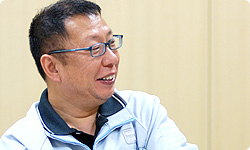
That was fun for me, too. At the time, when someone came to me and said, "I'm having trouble because there isn't enough memory," I was - to be honest - really happy. (laughs) Seeing if you could achieve programming for the same functions with a smaller amount of memory was one way for a programmer to show off.
We’d say, "If we just leave it to Iwata-san, he'll take care of it." (laughs)
I enjoyed that as I worked.
(flipping through the documents) For example, this castle was like that.
The castle at the start is small, and the one at the goal is big, but they're actually the same castle.
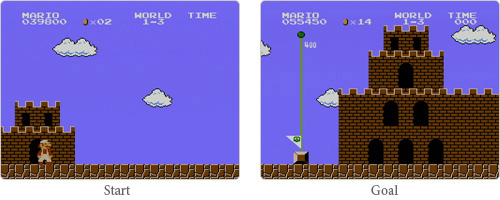
We took the top of the castle at the goal and used it at the start.
If you look closely at the castle at the goal, there's a door in an upper floor, but we insist it's a window! (laughs)
(laughs)
We were always thinking of tricks like that when we made Super Mario Bros.
About how we could make a game look richer with just a small amount of data.
We poured our strength into figuring out how to use a little data to represent a lot.
You began making Super Mario Bros. and came up with various artful contrivances to make the game a grand culmination of previous games. When did you sense that it had become something amazing?
Without a doubt, when we did the background.
When it went from black to a blue sky.
Yeah.
(picking up a planning sheet) Here it is.
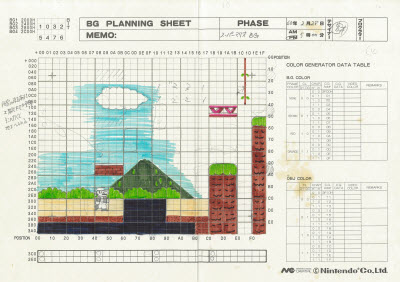
Oh, there it is!
Tezuka-san, did you draw this?
I think maybe it was Miyamoto-san.
Miyamoto-san?
Did I draw this? Yeah, it's mine. I signed it. (laughs)
Looking at the date... it's signed February 28, 1985. Only a week had passed since the first specifications.
Don't I work fast?
(laughs)
There's a palette in the upper right-hand corner of this planning sheet. We used that to manage things - like by making the greenery and clouds out of the same parts.
The greenery and clouds are made from the same parts, and you could only use four colours for each one. You filled into the palette which colours you wanted to use for those four colours. That was a feature of the Famicom hardware. If you change the combinations of the four colours, the same object can look amazingly different. We made full use of that back then.
Yeah. In order to put a bigger game than any other into the small capacity of the Famicom cartridge, we had to come up with ideas like that to pack in content.
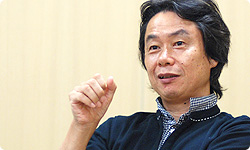
That kind of puzzle-solving was a big part of making Super Mario Bros. games.
It was fun making games that way.
It sure was.
That was fun for those of us making the game, and the resulting levels were fun for the players.
Who designed the levels?
Tezuka-san and I.
We designed them together.
No one but Tezuka-san and I drew them.
It's true. It was just them.
We drew them all. That way, different personalities meet in an interesting way that you wouldn't see if only one person did them.
Tezuka-san, what did you have in mind at that time with regard to landform design and placement of enemies? Even 25 years later, everyone recognises that the placement of enemies in Super Mario Bros. is interesting. How did such impressive mapping come about?
Um...
And you can't just say, "By chance." (laughs)
It wasn't by chance. (laughs) As I designed a level, I would anticipate how the players would play it, and then I would show it to Miyamoto-san.
I see.
He would look at it and make comments like, "The player will probably approach it this way. When an enemy appears here, the player will run this way, but we don't want the player to hit Mario's head on that, so..." Then I'd fix what didn't feel right.
Tezuka-san, did you comment on the maps Miyamoto-san made?
Did I?
... (laughs)
Or was Miyamoto-san always the master?
(firmly) He was the master. Back then, you could only see a working version of a map you'd drawn once a day, so you tried to make it as good as possible on paper.
Oh, right. That was another restriction, but maybe there were benefits to that. At the time, we didn't have all the convenient tools that we do now, so you couldn't just plop in an item and check it right away. If you designed a sloppy level, you'd waste a whole day.
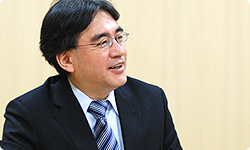
Despite the way it looks... I really thought about it.
(laughs) Sorry.
He was just a new guy, but he thought about it as hard as he could.
